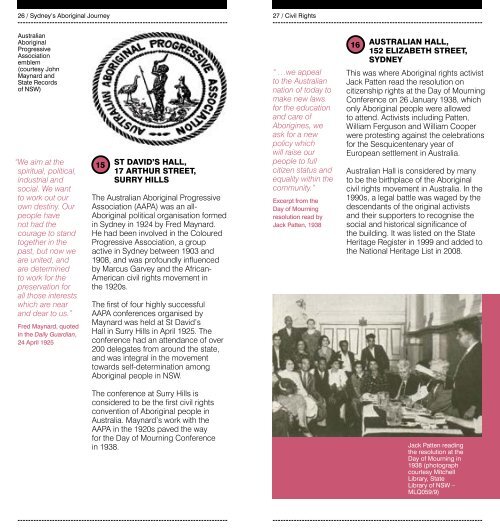BaramiBarabuguWalkTour_v3
BaramiBarabuguWalkTour_v3
BaramiBarabuguWalkTour_v3
Create successful ePaper yourself
Turn your PDF publications into a flip-book with our unique Google optimized e-Paper software.
26 / Sydney’s Aboriginal Journey<br />
27 / Civil Rights<br />
Australian<br />
Aboriginal<br />
Progressive<br />
Association<br />
emblem<br />
(courtesy John<br />
Maynard and<br />
State Records<br />
of NSW)<br />
“We aim at the<br />
spiritual, political,<br />
industrial and<br />
social. We want<br />
to work out our<br />
own destiny. Our<br />
people have<br />
not had the<br />
courage to stand<br />
together in the<br />
past, but now we<br />
are united, and<br />
are determined<br />
to work for the<br />
preservation for<br />
all those interests<br />
which are near<br />
and dear to us.”<br />
Fred Maynard, quoted<br />
in the Daily Guardian,<br />
24 April 1925<br />
15<br />
St David’s Hall,<br />
17 Arthur Street,<br />
Surry Hills<br />
The Australian Aboriginal Progressive<br />
Association (AAPA) was an all-<br />
Aboriginal political organisation formed<br />
in Sydney in 1924 by Fred Maynard.<br />
He had been involved in the Coloured<br />
Progressive Association, a group<br />
active in Sydney between 1903 and<br />
1908, and was profoundly influenced<br />
by Marcus Garvey and the African-<br />
American civil rights movement in<br />
the 1920s.<br />
The first of four highly successful<br />
AAPA conferences organised by<br />
Maynard was held at St David’s<br />
Hall in Surry Hills in April 1925. The<br />
conference had an attendance of over<br />
200 delegates from around the state,<br />
and was integral in the movement<br />
towards self-determination among<br />
Aboriginal people in NSW.<br />
“ …we appeal<br />
to the Australian<br />
nation of today to<br />
make new laws<br />
for the education<br />
and care of<br />
Aborigines, we<br />
ask for a new<br />
policy which<br />
will raise our<br />
people to full<br />
citizen status and<br />
equality within the<br />
community.”<br />
Excerpt from the<br />
Day of Mourning<br />
resolution read by<br />
Jack Patten, 1938<br />
16 Australian Hall,<br />
152 Elizabeth Street,<br />
Sydney<br />
This was where Aboriginal rights activist<br />
Jack Patten read the resolution on<br />
citizenship rights at the Day of Mourning<br />
Conference on 26 January 1938, which<br />
only Aboriginal people were allowed<br />
to attend. Activists including Patten,<br />
William Ferguson and William Cooper<br />
were protesting against the celebrations<br />
for the Sesquicentenary year of<br />
European settlement in Australia.<br />
Australian Hall is considered by many<br />
to be the birthplace of the Aboriginal<br />
civil rights movement in Australia. In the<br />
1990s, a legal battle was waged by the<br />
descendants of the original activists<br />
and their supporters to recognise the<br />
social and historical significance of<br />
the building. It was listed on the State<br />
Heritage Register in 1999 and added to<br />
the National Heritage List in 2008.<br />
The conference at Surry Hills is<br />
considered to be the first civil rights<br />
convention of Aboriginal people in<br />
Australia. Maynard’s work with the<br />
AAPA in the 1920s paved the way<br />
for the Day of Mourning Conference<br />
in 1938.<br />
Jack Patten reading<br />
the resolution at the<br />
Day of Mourning in<br />
1938 (photograph<br />
courtesy Mitchell<br />
Library, State<br />
Library of NSW –<br />
MLQ059/9)


